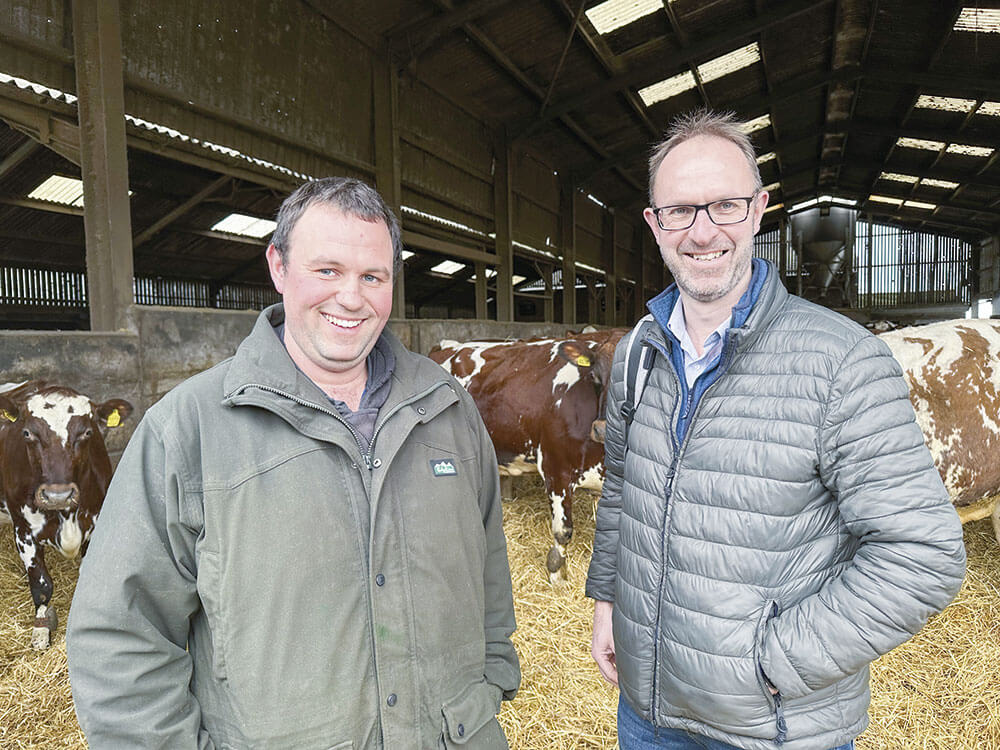
Lupins have long been promoted as a quality protein for ruminants and so they are proving for one Derbyshire dairy farm.
A higher quality protein than either peas or beans and featuring a similar amino acid profile to soya, lupins are kind on the rumen and easy to incorporate into the diet, so why are they not more popular with livestock farmers? A lack of arable land on most livestock units may be one reason but to those who have tried, they have more than rewarded the time and effort invested.
Lupins are not a new crop, explains David Thornton, Agrii feed and nutrition specialist, but their nutritional profile means they are often promoted as a sustainable alternative to soya (see Table 1).
“Their superior nutritional profile compared with other combinable legumes means they have been on the cusp of a breakthrough for decades, but poor yield stability and a disconnect between arable farmers able to produce them and livestock farmers wanting to consume them has served as a barrier to their adoption,” he says.
Such hurdles are no longer the deterrent they once were. Variety trials by Agrii have identified those that mature earlier which has extended their suitability outside the south and east while yields too are now far more reliable. An appreciation for the role sustainable feed sources play in supporting efforts to reduce the carbon footprint of agriculture too has strengthened their appeal.
“Lupins are easier to feed than other grains and without the health issues that come with some sources of protein. They are also highly suitable for young ruminants and can be fed from 15-weeks through to maturity in the case of lambs or fattening cattle,” Mr Thornton says.
In the rearing stage, lupins are often favoured to grass or maize silage because of their higher protein content while in finishing rations, they are a good complement to maize silage which is higher in energy, but lower in protein.
For wholecrop silage, dry matter yields are on a par with maize, typically 15t DM/Ha while grain yields vary depending on the type grown. White (semi-determinate) lupins can yield up to 5t/Ha while blue (determinate), which tend to suit conditions in the west and north, yield 3.5-4 t/Ha.
“The grain is high in digestible oils, which is why livestock tend to look well on them. This is a good complement to the starch-based energy of cereal diets,” Mr Thornton adds.
Calculating the cost of growing and feeding your own lupins can be difficult as it depends on how you want to appraise them. In most cases, explains Mr Thornton, it makes sense to cost them as a soya replacement, but appreciating that it doesn’t cost anywhere near this to produce.
“The best use of lupins is probably in the dairy ration. The oil content is higher than soyameal (which has been extracted) and while you have to feed about 20% more, they are cheaper to grow. With soya on farm for about £520/t, lupins would be worth about £420/t on an equivalent basis but are reasonably cheap to grow,” he says. If there is one note of caution it is to ensure the crop is harvested when the pods are slightly soft if header losses are to be avoided.
“Unfortunately, the volunteers that follow can’t be grazed as the plant contains oxalic acid (an anti-nutritional found in nettles and some forage crops). Oxalic acid can bind with dietary calcium and magnesium to form insoluble Ca or Mg oxalate.
In ruminants, health issues occur when animals consume large quantities of oxalaterich material, so combining before the pods are brittle is advisable,” Mr Thornton says.
Good fit with arable and dairy
For Derbyshire arable and dairy farmer Richard Harris, the blue lupin variety Primadonna, has replaced soya as the source of quality protein, meant an end to the feet and udder problems associated with large quantities of faba beans and provided an opportunity to clean up some of the weedier fields at Old Hall Farm, Alkmonton.
“Lupins present a range of benefits to us,” Mr Harris says. “First, they are a viable alternative to imported soya which means we can advertise our milk as having a lower carbon footprint. As a business selling 15,000 litres a week direct to consumers it is important that we are seen to be moving with the times. Second, the cows are generally healthier with less feet and udder problems. Third, the lupin, faba bean and rapemeal blend we feed is about £100/t cheaper than the bought-in equivalent containing soya, so there is a significant financial saving too,” says Richard Harris.
Incorporating them into the diet was as simple as providing a nutritional analysis to his ration consultant (see Table 2).
“Lupins don’t tend to feature in many ration programmes, so the nutritional profile had to be entered manually. From here it was about finding the right ratio of lupins to faba beans to balance the ration, but because they are easy on the rumen, we can afford to be fairly flexible with the inclusion rate,” he says.
Table 1: Nutrient profile of grain legumes
.
| GRAIN LEGUMES | CRUDE PROTEIN (%) | OIL (%) | CRUDE FIBRE (%) |
|---|---|---|---|
| Lupins Lupinusangustifolius (narrow-leaf/blue) Lupins albus (white) Lupinus luteus (yellow) | 28-38 34-45 36-48 | 5-7 10-15 4-7 | 13-17 3-10 15-18 |
| Soybean Meal | 48.0 | 2.8 | 3.5 |
| Faba Beans | 29.0 | 1.5 | 9.0 |
| Peas | 24.9 | 1.5 | 19.5 |
Table 2: Typical feeding plan at Old Hall Farm
(cows giving 26 litres/day)
| FRESH | DRY | |
|---|---|---|
| Grass silage (1st cut) | 21.0 | 5.1 |
| Grass silage (3rd cut) | 7.0 | 2.62 |
| Wholecrop wheat | 7.0 | 3.74 |
| Cold pressed rape | 1.0 | 0.88 |
| Maxcare Dairy Extra | 0.150 | 0.147 |
| Lupin/bean blend | 3.5 | 3.03 |
| Rolled barley/wheat blend | 3.5 | 3.01 |
| Emerald 18 | 2.0 | 1.73 |
| Actual intake (kg) | 45.2 | 20.3 |

The Harris family milks 200 Ayrshire and 30 Guernsey cows with a herd average of 6,500 litres per cow. The Guernseys are kept specifically to produce the higher butterfat milk favoured by those who enjoy channel island milk while the Ayrshires offer a tastier alternative to the Holstein-Friesian equivalent and offer a point of differentiation when selling direct to consumers.
“From the moment we went into dairy in 2013, our plan was always to develop the direct-to-retail business. Today, 75% of our milk production is sold direct to households or business users with the majority of it delivered via one of our four vans.
We recently added cream and butter to the list of dairy products, with interest in these growing steadily,” he adds.
Lupins, he believes, offered an opportunity to support the milk profile and benefit cow health without incurring extra costs. But what about growing them, haven’t they taken the place of a crop delivering a higher gross margin?
Across 280 hectares (700 acres) of arable at Old Hall Farm, lupins are grown on just 20Ha because the 75 tonnes produced is about enough to meet requirements.
As a break crop, lupins typically follow a second wheat. The opportunity they afford to clean up land is especially appreciated and this season they will go on ground with an emerging rye-grass burden as part of a wider effort to prevent this from becoming an established problem.
“This is my third year growing lupins and there have been some lessons learned along the way. The biggest being not to leave them too late before combining as header losses at harvest can be significant. They need a flat seedbed as the plants can be quite short and pods can be close to the ground,”
Mr Harris says.
CROP AGRONOMY
Agrii agronomist Tim Coltman is responsible for advising on the crop protection needs at Alkmonton Old Hall Farm. Aside from giving lupins a good start and not leaving them too late to combine, he says they are an easy crop to manage.
“Lupins aren’t especially competitive, so a clean seedbed is always preferable. In most cases, this is easily achieved with a pre-emergence spray of clomazone and pendimethalin.
“From here on, it is straightforward. The crop receives a fungicide at stem extension along with a graminicide for any grassweeds that may have come through the residual at pre-emergence. Nutrition is equally easy. Zoom, a foliar complex of manganese, sulphur, magnesium, boron, molybdenum and
some nitrogen along with humic acid is applied at 2 litres per Ha,” Mr Coltman says.The final crop protection task is to apply a pod-sealant in the weeks before harvest to minimise pod-shatter losses caused by heavy weather or at combining. “Once the majority of pods are at full size a pod-sealant is included with glyphosate at desiccation to minimise losses and ensure even maturity,” Mr Coltman says.


